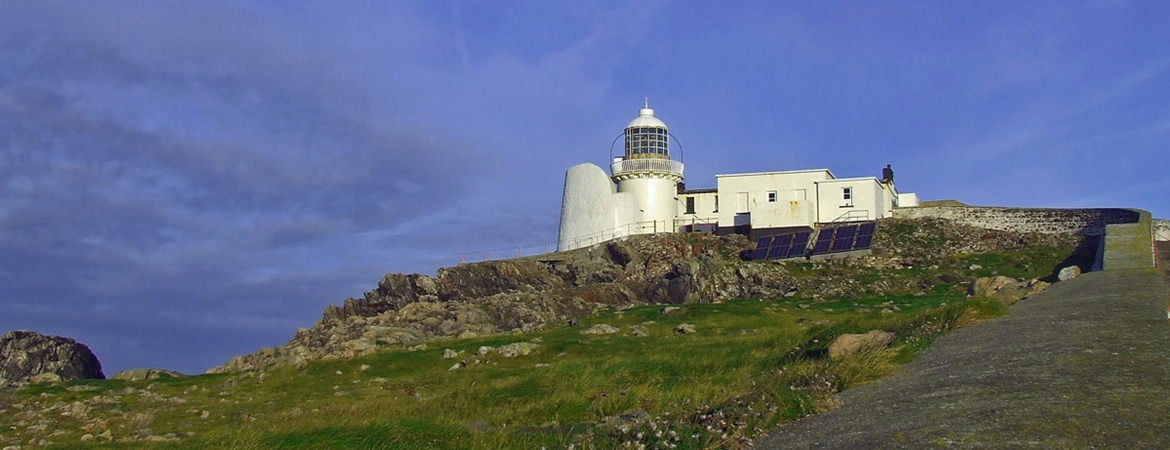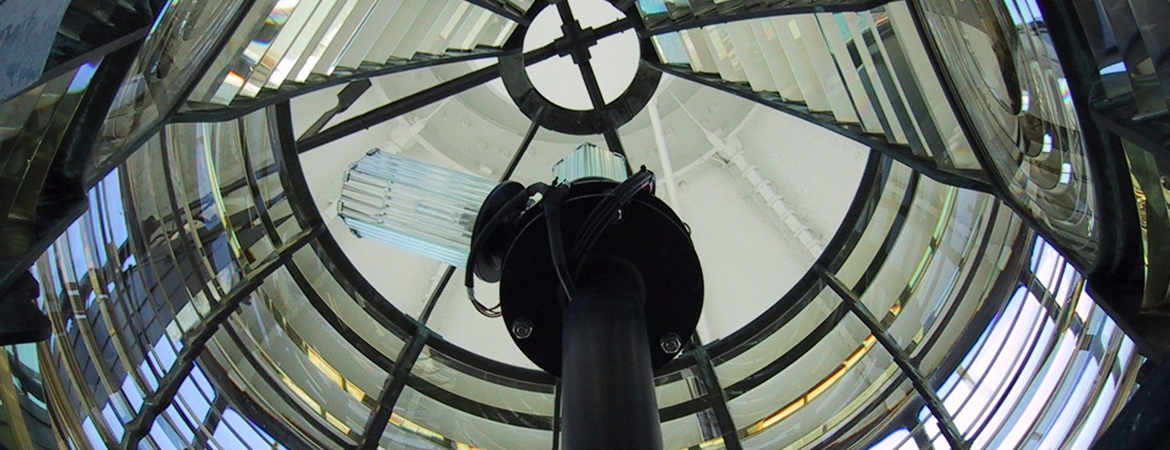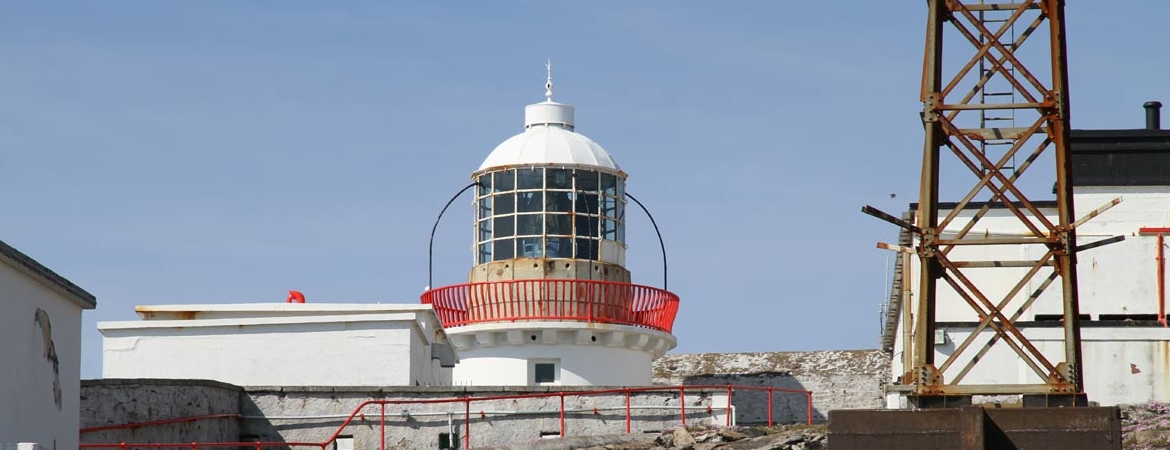The Board informed Admiral Paget, through whom the application was made, that Eagle Island had been selected as the most suitable location and Trinity House gave its sanction on 27th November 1830.
Two lighthouses were built, Eagle Island East and Eagle Island West. The base of the West tower was 196 feet above high water and during the construction a great sea swept the partly built tower, two courses high, and much of the building materials clear into the sea. The two towers were finally completed and a massive storm wall was built on the sea side of the towers. The towers, 64 feet and 87 feet high were 132 yards apart with their lanterns at the same level, 220 feet above high water. When the two lights at night, or towers in daytime, were in line they guided vessels past all dangers from Blacksod Bay to Broadhaven including The Stags. The towers, built of cut stone quarried on the Island were painted white and had first order catoptric fixed white lights visible for twenty miles in clear weather.
The cost of the whole establishment until the end of 1839 was £36,418-10s-1d. The works were not quite complete when the lights were first established on the night of 29th September 1835.
Eagle Island seems destined to be struck by severe storms. On the night of 17th January 1836 the lantern of the West tower was struck by a rock shattering one of the panes of glass and extinguishing the light but the Keepers had the light working again within an hour. The Keepers' dwellings were badly damaged and in those days Keepers and their families lived on the island. Both lanterns were badly damaged by a violent gale on 5th and 6th February 1850 and the lights were not restored until the 11th because the man sent out to repair them could not make the passage until the 14th, when a landing was effected and the whole story told.
On the 11th March 1861 at midday the light room of the East tower was struck by the sea smashing 23 panes, washing some of the lamps down the stairs, and damaging the reflectors with broken glass beyond repair. It must have been an incredible wave to have come up 133 feet of rock and then a further 87 feet of lighthouse tower to cause so much damage. In spite of the efforts of the Keepers to repair the damage it wasn't until the night of the 12th that the light was restored and then only with 12 lamps and reflectors.
Another interesting aspect of this disaster was that so much water cascaded down the tower it was impossible for the Keepers to open the door of the tower. They had to drill holes in the door to let the water out.
The storm which struck Eagle Island and many other west and north coast stations on 29th December 1894 damaged the dwellings of the East station beyond repair and also broke the lantern glass, put out the light and damaged the protecting wall. The families took shelter in the tower and it was not until the next day that the families at the West tower realised their friends' plight. Women and children were brought ashore and housed in Belmullet.
Mr Douglas, the Commissioners' Engineer suggested in his report that the East station should be abandoned and the West should be improved. In the meantime, the fixed light apparatus that had been taken out of Tory Island should be installed at the West station with a six wick burner and the East tower worked by Keepers at the West dwellings. This state of affairs lasted until 1st November 1895 when the new dioptric first order light at the West station came into operation and the East tower was discontinued and lopped by 20 feet so that it did not cause a shadow. The new light was group occulting and showed white towards the sea and red towards land.
Shore dwellings for the keepers and their families were built at Corclough on the Termoncarragh Road near where the keepers could semaphore to the island. The families moved into the dwellings at the end of 1900.
A fog signal on Eagle Island was requested in 1910 and 1914 but it was not until 1917 that, at the expense of the Admiralty, an explosive fog signal was installed. Although the Admiralty intimated that they had no further use for the fog signal in 1920 the Commissioners retained it at the station until the Irish Free State Army removed the explosive charges in May 1923. A Notice to Mariners was then issued as to the unreliability of the explosive fog signal. The fog signal was discontinued but was re-established in July 1924 when the charges were returned. In September 1927 a diaphone fog signal replaced the explosive fog signal. From April 1978 the light at Eagle Island was exhibited in poor visibility when the fog signal was sounding. The fog signal was discontinued in May 1985.
A new 3rd order triple flashing catoptric lens was exhibited on 5th February 1927 and the red cuts were abolished.
On the 25th January 1935 another storm struck the light putting it out of action. The Keepers were commended on their action of operating the fog signal while the light was defective.
21st January 1937 saw the establishment of a Radiobeacon. This beacon sent out a Morse signal, G L, every six minutes in conjunction with five other radiobeacon stations, two in Ireland, one in Scotland, one in the Scilly Islands, and one in France. Thus a continuous service on a selected frequency could be picked up by a vessel and its position determined on a chart from bearings obtained from two or three of these stations. From 1st April 1992 the Radiobeacon operated continuously, in accordance with new internationally agreed regulations whereby it was agreed that Medium Frequency Maritime Beacons should operate singly and continuously rather than in groups on a time shared basis. In more recent times utilisation of radio direction finders by Mariners has been to a great extent superseded by more modern technology. For this reason the Commissioners discontinued their Medium Frequency Radiobeacon service on 1st February 1999.
The shore dwellings were abandoned in 1955 and sold in October 1956.
The light was converted to electric on 17th July 1968 with the same character-group flash 3 white every 10 seconds; the candlepower was increased to 1,400,000 with a range of twenty six miles. On 8 October 2001 the light was replaced by a solar powered light with a range of 19 nautical miles. The character was changed to 3 white flashes every 15 seconds.
Reliefs were for a long time carried out by contractor's boat from Scotchport, two miles south of the island on the Mullet. However from 1969 a helicopter took over, landing the Keepers at Blacksod.Substantial damage was again done by storms in January 1987 and February 1988.
On 31st March 1988 the lighthouse was converted to automatic operation and the Keepers were withdrawn from the station. The station is in the care of an Attendant and the aids to navigation are also monitored via a telemetry link from the Lighthouse Depot in Dun Laoghaire.







